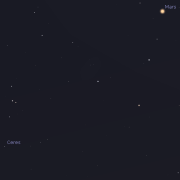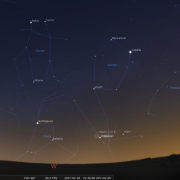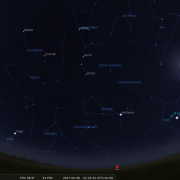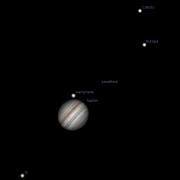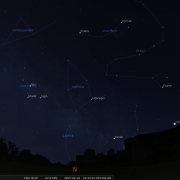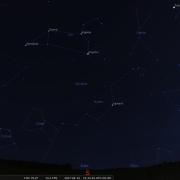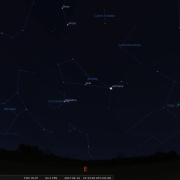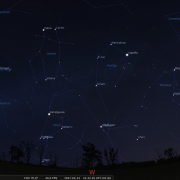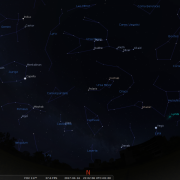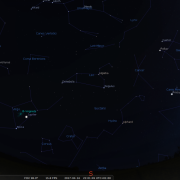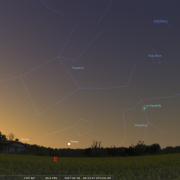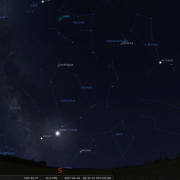In this month's Sky Notes:
Planetary Skylights
 Mercury remains on view low in the evening twilight sky until the second week of April. Look for the elusive planet across in the west approximately 45 minutes after sunset. On the 1st Mercury reaches greatest eastern elongation from the sun (greatest separation in the sky) but thereafter rapidly falls back toward the horizon, fading as it does so and is lost to view after the 12th.
Mercury remains on view low in the evening twilight sky until the second week of April. Look for the elusive planet across in the west approximately 45 minutes after sunset. On the 1st Mercury reaches greatest eastern elongation from the sun (greatest separation in the sky) but thereafter rapidly falls back toward the horizon, fading as it does so and is lost to view after the 12th.
 Mars is also visible low in the west, upper left of Mercury (or mercury lower right of Mars) The red planet is slowly (very slowly) losing ground in the bright twilight, but will still be visible at the end of the month. On the 10th Mars lies less than 3 degrees upper right of the dwarf planet Ceres, which should be visible in a pair of binoculars. From mid month Mars moves up (seemingly) between the star clusters of the Pleiades and the Hyades, both in Taurus. A crescent moon joins them on the 28th making for a pleasing spectacle to the naked eye.
Mars is also visible low in the west, upper left of Mercury (or mercury lower right of Mars) The red planet is slowly (very slowly) losing ground in the bright twilight, but will still be visible at the end of the month. On the 10th Mars lies less than 3 degrees upper right of the dwarf planet Ceres, which should be visible in a pair of binoculars. From mid month Mars moves up (seemingly) between the star clusters of the Pleiades and the Hyades, both in Taurus. A crescent moon joins them on the 28th making for a pleasing spectacle to the naked eye.
|
10-Apr-2017, 21:15h:
Mars and Ceres Click for full-sized image |
28-Apr-2017, 21:45h:
(looking South): Mars and Moon Click for full-sized image |
 Mighty Jupiter takes centre stage in the April night sky coming to opposition on the 7th when it resides due south at midnight. Look for the beacon of Jupiter low down in the south east as twilight begins to fall. Observing Jupiter is a must for anyone with a telescope; even binoculars will reveal the Galilean moons. Note the dark banding across the disk, and if visible the great red spot, which will appear as pale oval hollow on the southern dark equatorial belt. A modest telescope should reveal it, however as Jupiter rotates in less than ten hours, the GRT is not always orientated in our direction. Incidentally the star below Jupiter is Spica – chief star in Virgo. A waning moon resides close by on the 10th.
Mighty Jupiter takes centre stage in the April night sky coming to opposition on the 7th when it resides due south at midnight. Look for the beacon of Jupiter low down in the south east as twilight begins to fall. Observing Jupiter is a must for anyone with a telescope; even binoculars will reveal the Galilean moons. Note the dark banding across the disk, and if visible the great red spot, which will appear as pale oval hollow on the southern dark equatorial belt. A modest telescope should reveal it, however as Jupiter rotates in less than ten hours, the GRT is not always orientated in our direction. Incidentally the star below Jupiter is Spica – chief star in Virgo. A waning moon resides close by on the 10th.
|
08-Apr-2017, 21:30h:
Moon and Jupiter Click for full-sized image |
07-Apr-2017: Jupiter with
Moons at Opposition Click for full-sized image |
 Saturn rises in early morning hours and is best viewed telescopically shortly before dawn (around an hour). Saturn resides to the left of a bright red star – Antares, chief star of Scorpius. Look on the 16th when a waning crescent moon lies upper right of Saturn.
Saturn rises in early morning hours and is best viewed telescopically shortly before dawn (around an hour). Saturn resides to the left of a bright red star – Antares, chief star of Scorpius. Look on the 16th when a waning crescent moon lies upper right of Saturn.
 Finally, at the end of April Venus emerges into the dawn sky around 05:00h very low to the east horizon.
Finally, at the end of April Venus emerges into the dawn sky around 05:00h very low to the east horizon.
Meteor Showers

The Lyrid meteor shower peaks during the day of April 22nd , so the night of 21/22 and 22/23rd should yield some visible shooting stars, especially as the moon will be out of the way. The hourly rate exceeds 25, however observed
rates will at best be half this. As with all meteor showers the early morning hours offer the best returns.
A number of lesser meteor showers occur during April. The Virginids and alpha Scorpiids each have zenith hourly rates (ZHR) of around half a dozen, equating to ‘normal’ sporadic meteor activity levels. The Virginids peak on April 7/8th, which is a ‘no moon’ window, therefore increased sightings of Virginids during the early morning hours is quite likely. The Scorpiids peak on the 27th and will be hampered a little by a waning moon in the early morning hours.
Comet 41P Tuttle-Giacobini-Kresák
Yes I know, yet another mouthful, but you may call it Comet 41P or even Comet TGK, and hopefully it should be visible from the last week of March and well into April. At its closest on April 5th, the comet will be moving a huge two degrees a day (that’s the width of four Full Moons!) as seen from the Earth passing through the celestial dragon of Draco.
Orbiting the Sun once every 5.4 years, this is the 29th perihelion return of the comet since its discovery in 1858. The comet’s orbit takes it out to near the orbit of Jupiter with perihelion just 0.13 AU outside the orbit of the Earth. The comet’s passage in 2017 is about as close as it gets to Earth, indeed it is the closest approach in our lifetime. Currently around +9th magnitude, the comet should flirt with naked eye visibility of (magnitude +6) in early April. Comet 41P is also worth watching, as it’s known for periodic outbursts, reaching mag +3.9 in 1973.
However please remember comets should come with a observational health warning –so to speak- ;ie they hardly ever do what they are supposed to do. So if you are going to track 41P down, pick a dark window night, have patience and use a star chart (actually it can be more fun than it sounds) Use binoculars, they will reveal the comet easily, before trying to spot it with the naked eye – if possible! Below are listed some highlights.
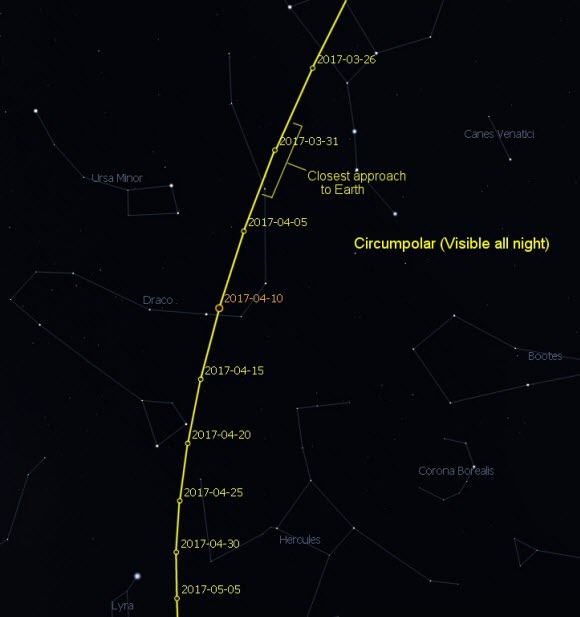
Tracking Comet 41P Tuttle-Giacobini-Kresák
April 2nd: Passes near the 3.6 magnitude star Thuban (Alpha Draconis)
April 5th: Passes just 0.15 AU (23.2 million kilometers) from the Earth at 13:30 UT. April 11th: reaches perihelion at 1.05 AU (162.7 million kilometers) from the Sun.
April 18th: passes the 2.7 magnitude star Rastaban (Beta Draconis)
April 2017 Sky Charts
Click each image to see a full-size Sky Chart:
Additional Image Credits:
- Planets and Comets where not otherwise mentioned: NASA
- Sky Charts: Stellarium Software
- Log in to post comments

